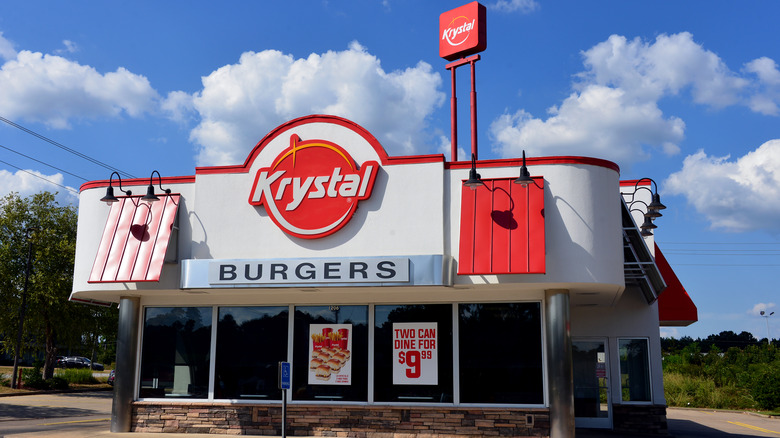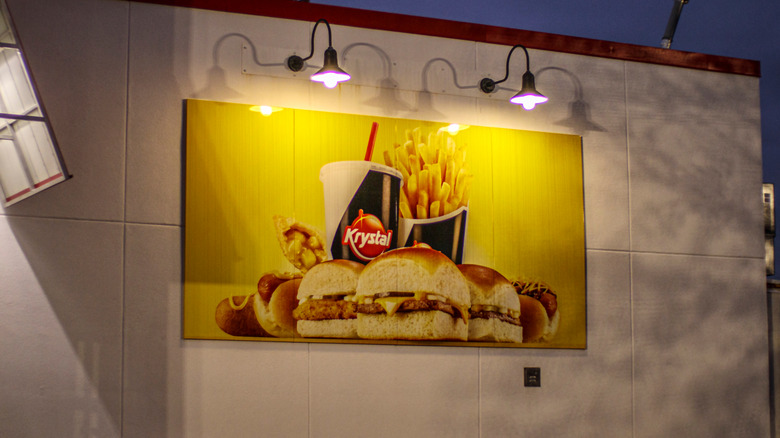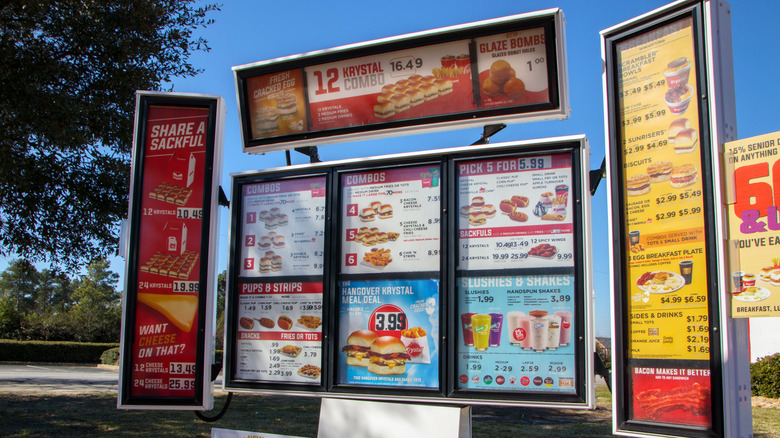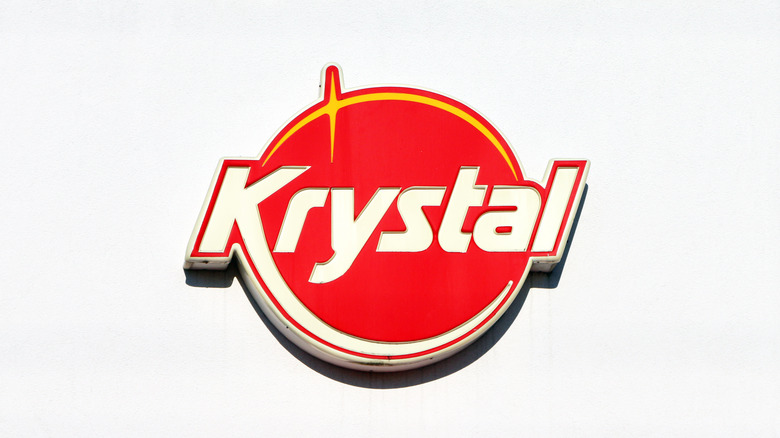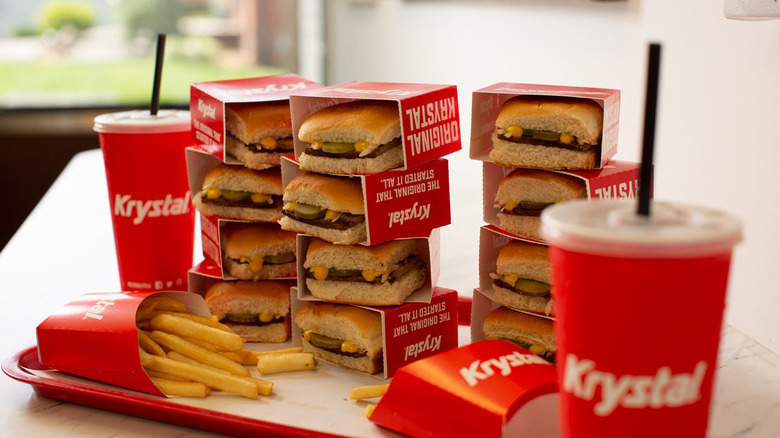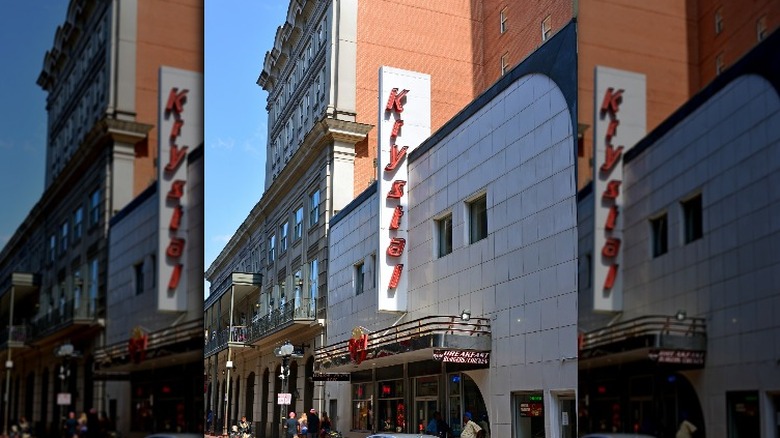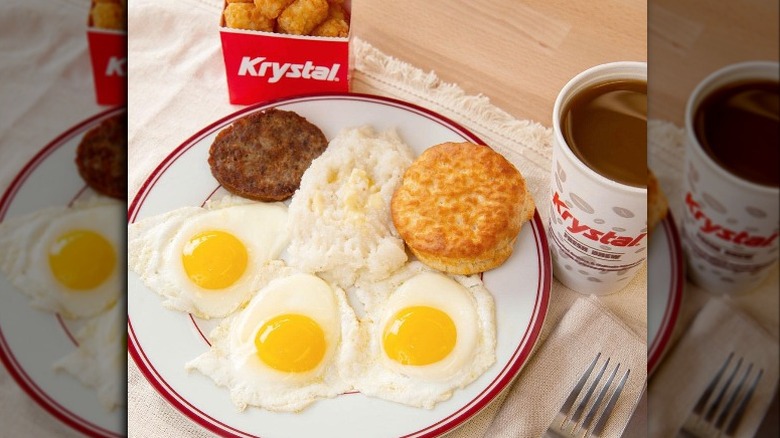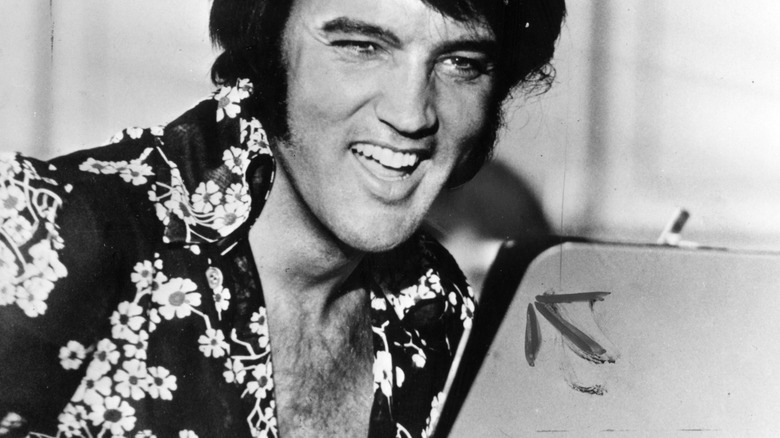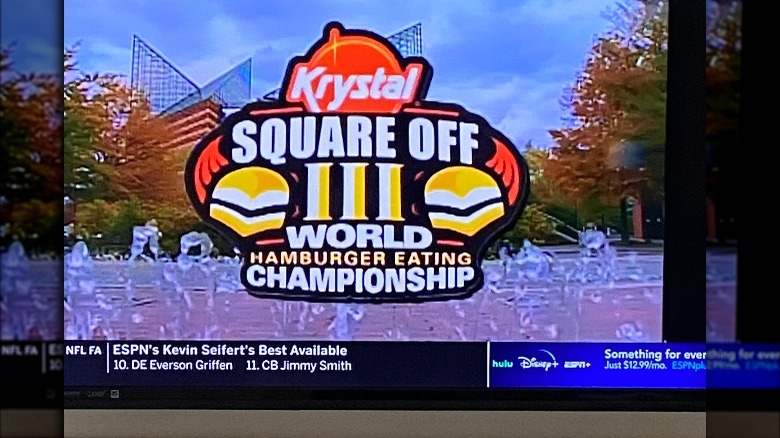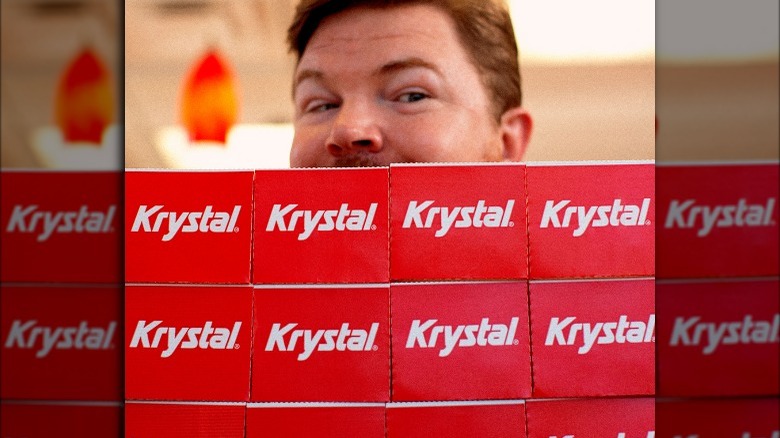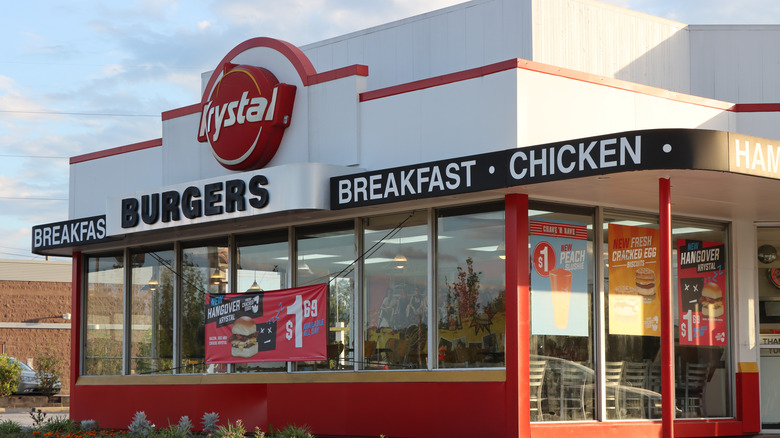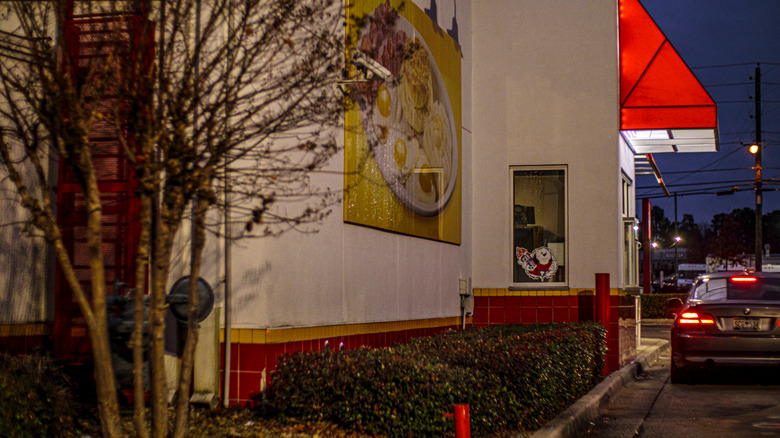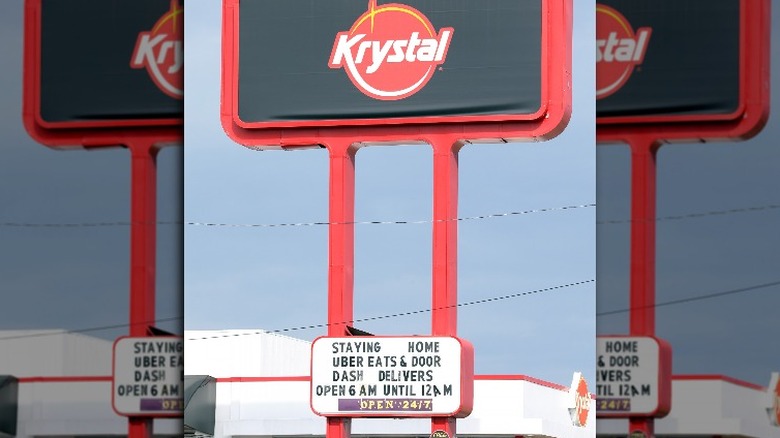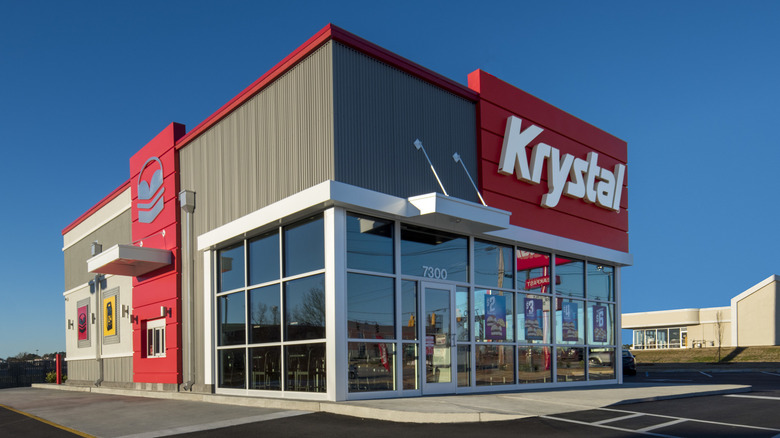The Untold Truth Of Krystal
Travel to the southeastern U.S. and you'll find that, when it comes to dining on miniature, square hamburgers, your options slowly change the further south you travel. Whereas White Castle reigns supreme in the Midwest and North, Krystal is king in the South. Spread out over a relatively small area of 10 states, the Atlanta-based restaurant serves hungry customers at nearly 300 locations and was, in 2019, named one of USA Today's Top 10 best regional fast-food restaurants.
Long-time Krystal fans will recognize the restaurant on sight. The white and red narrow exterior and the crystal ball on the sign (a nod to the name) set this restaurant apart from other fast-food restaurants on any city's main drag. The miniature hamburgers, miniature chicken sandwiches, miniature breakfast sandwiches, and even miniature chili dogs and corn dogs make up a menu that's simple, but satisfactory.
But as is the case with every long-standing fast-food brand, though, Krystal's history isn't as simple as its menu.
When the first Krystal restaurant opened in 1932, it was basically a rip-off of White Castle
If you're a diehard White Castle fan with little exposure to the Krystal brand, you may look at the Krystal burger and menu and immediately think, "Hey! That looks a lot like White Castle's food!" and you'd be right. That's partially because the first Krystal restaurant, which opened in 1932, was basically a rip-off of the earlier, already established White Castle. It's a part of Krystal history that the brand doesn't deny.
According to a Chattanooga Today article, one of the two founders, Rody Davenport Jr., traveled into White Castle's northern territory during the Great Depression and stopped by one of the restaurants. Impressed by the White Castle model, he went back to Chattanooga, teamed up with co-founder J. Glenn Sherrill, and opened the first Krystal restaurant in October of 1932, channeling the already established White Castle focuses on cleanliness, affordable food, and a highly-trained staff. Even the burgers, with their small, square shape, were similar to White Castle's offerings.
The first Krystal restaurants focused on burgers and coffee only
Also similar to White Castle, which opened with a four-item menu consisting of sliders, apple pie, coffee, and Coca-Cola, the first Krystal restaurant also stuck to a small menu. The Krystal menu was even smaller than White Castle's, though, focusing on sliders and coffee only, according to the Tennessee Encyclopedia. The idea was to provide a good meal during the Great Depression, with a focus on high-quality coffee and sliders that were just a nickel each. Like the White Castle slider, the Krystal slider was steamed, square, and topped with chopped onions.
Today, both White Castle and Krystal sliders come topped with pickles, cheese (if desired), and onions, though Krystal has set itself apart with a dollop of mustard. As Fast Food Menu Prices compares, though, the current, primary differentiator between the two sliders? It's all about the buns, as the Krystal bun seems to have a little more "oomph" to it.
The name Krystal refers to the owners' crystal-clean cleanliness standards
So who was Krystal? Maybe one of the owner's daughters? Nope! The "Krystal" name actually refers to the owners' focus on cleanliness standards, something that was extremely important during the 1930s, as, at the time, ground beef didn't exactly have a great reputation, partially thanks to works like Upton Sinclair's "The Jungle," which portrayed beef in general as an unsanitary food item. White Castle was already paving the way for ground beef's enhanced reputation, but even when Krystal opened more than 10 years after the first White Castle location, the owners still had their work cut out for them.
As for why "Krystal" in order to indicate cleanliness, it all came down to Rody Davenport Jr.'s wife, who saw, as Chattanooga Today reports, a crystal ball at a neighbor's house and the phrase "clean as crystal" came to mind. To change things up a bit, the owners swapped the "C" for a "K" and Krystal was born. Today, you can still spot a nod to that first crystal ball sitting atop each Krystal location.
The second Krystal customer challenged the first Krystal customer to a Krystal-eating contest
Eating contests, such as possibly the most publicized and well-known eating contest, the Nathan's Famous July Fourth Hot Dog-Eating Contest, are nothing new. In fact, the first recorded eating contest, according to Lapham's Quarterly, took place in the late 19th century in Canada; the food in question was a series of pies and the winner received a book (woohoo!). At Krystal, eating contests became a thing almost as soon as Rody Davenport Jr. and J. Glenn Sherrill opened their doors.
According to Major League Eating and the International Federation of Competitive Eating, as history tells it, the second-ever Krystal customer, Roy Ward, challenged the first-ever Krystal customer, French Jenkins, to a Krystal-eating contest, boasting that he could eat twice as many Krystals as Jenkins. In order to prove it, he purchased 12 Krystals and ate them all, beating out French Jenkins and his six hamburgers and cup of coffee, which he'd purchased for 35 cents (via Chattanooga Today).
The first Krystal restaurants were designed like a diner counter
Today, if you go to a Krystal restaurant, you'll find that some offer in-restaurant dining rooms, but many are smaller restaurants with dual drive-thru service and a walk-up order counter (almost similar to the same set up you'll see at a Rally's or Checker's location). However, this design is relatively new. The first Krystal restaurants looked more akin to a diner counter, with customers seated at a series of stools along a lengthy counter. According to The Chattanoogan, all the way through the 1970s, Krystal restaurants operated like this, with customers coming through the door, picking a seat at the counter, and ordering from a waitress, who would call out the order to the cook. In the 1970s, Krystal restaurants switched to a counter-service model, wherein guests walked in, placed their order at a counter, and then carried their food to non-counter seating options like tables and booths.
Krystal set itself apart by serving food on real porcelain and china plates
Something you probably don't expect to see when dining at a fast-food restaurant? A real plate. However, Krystal set itself apart all the way through the 1950s by serving its food on just that: a real, porcelain plate, rather than using wrappers or boxes, like the competition. Around that time, Restaurant News also says, the Krystal menu was also expanded a bit, to include french fries, chili, and milkshakes (bacon, eggs, and pie had been added earlier), and drive-thrus were added to many Krystal locations.
Despite all the change and progress, though, the porcelain plates helped Krystal keep in touch with its roots and its namesake dedication to cleanliness. The plates reflected the founders' wish for the actual Krystal restaurant building to look as clean as possible, which prompted them to use porcelain for the exterior (via Chattanooga Today). The white porcelain and stainless steel building pieces were manufactured in Chicago before being shipped, prefabricated, to restaurant locations for assembly.
Elvis was a Krystal fan
It's been well-documented that Elvis Presley didn't have the healthiest relationship with food, and Even The King loved Krystal, according to wife Priscilla Presley. She says, in a Local Memphis interview, that Elvis loved Krystal sliders, saying "The hamburgers were so small! He didn't like big things to eat." It was a love he shared with DJ Dewey Phillips, who helped launch Elvis Presley's career.
In the book "Dewey and Elvis: The Life and Times of a Rock 'n' Roll Deejay" by Louis Cantor, this love is attributed to both men's fairly impoverished upbringings, stating that, for Phillips, the burgers, and particularly buying sacks of them for a group, were like an "opulent" treat. The book states that Presley and Phillips would order as many as a hundred burgers at once and then, Phillips' wife says, "they'd come walking in the front door both of 'em carrying just sacks full of those durn things." Phillips' son also recalls eating the leftover Krystals the day after the two men would bring them home to feed all their friends.
During the 2000s, Krystal hosted Krystal-eating contests called Krystal Square Offs
While, as we can see with the case of Roy Ward and French Jenkins, Krystal customers have been challenging each other to Krystal-eating contests quite literally since the first Krystal restaurant opened its doors, it wasn't until 2004 that these eating contests became official and Krystal-sanctioned, with the founding of the Krystal Square Off World Hamburger Eating Championship. According to Major League Eating, the Krystal Square Off was one of only two major events in competitive eating and the only world hamburger-eating contest with Major League Eating sanction. Unfortunately, the Krystal Square Off events didn't last long. The last event took place in 2009 and the event's Twitter profile hasn't been updated since.
So, just how many Krystals do you have to eat to win the Krystal Square Off? At the last event, professional speed-eater Takeru Kobayashi won the contest by eating 93 burgers in eight minutes (via The Chattanoogan). Previously, contestants had eaten over 100 burgers over the course of the challenge's eight minutes, but the challenge organizers imposed a new no-dunking rule in 2009, which likely slowed the contestants down.
There's a Krystal Lovers Hall of Fame
In 2005, Krystal created its Krystal Lovers Hall of Fame (via The Chattanoogan). The Hall of Fame recognizes the brand's biggest fans and, each year, Krystal chose 10 new inductees from 10 different locations based on submitted stories and applications. In recognition of each inductee, Krystal created a caricature based on each and then featured that caricature on Krystal burger boxes for a limited time, alongside fun facts about the inductees, as well as their favorite menu items. Over the years, inductees included life-long dedicated employees, couples who ate Krystal burgers at their wedding, and diners who would travel from the North to their nearest Krystal location in the South on a regular basis.
The last Krystal Lovers Hall of Fame induction seems to have taken place in 2009, though, as the Krystal Lovers Hall of Fame web page has been removed, as has the Krystal Lovers Hall of Fame social media profiles, and the 2009-2010 induction was the last covered in news outlets.
Krystal was a pioneer in offering customers free WiFi
Currently, it's difficult to imagine going to a fast-food restaurant and not being able to log on to the restaurant's WiFi. If you're ever traveling and need to get some work done, fast-food restaurants are reliable spots to sit with your laptop for an hour or two. However, this wasn't always the case and, when Krystal began offering free WiFi to customers in 2003, the brand was considered a pioneer in the industry.
According to QSR Magazine, Krystal first launched its "Krystal HotSpot" in 2003 and then rolled out the hotspots to all of its locations in 2005. At the time, the brand was the largest provider of free WiFi of any fast-food chain in the country and the only brand to offer free WiFi in all locations. Each Krystal HotSpot allowed for up to 32 customers to access the hot spot at once, with no need for a password or payment.
One study found Krystal's drive-thru service to be the most accurate in the biz
What matters more when going through the drive-thru at your favorite fast-food restaurant — speed or accuracy? While ideally each fast-food restaurant would offer a combination of both, most would probably agree that they could stand to wait a little bit longer for their food, if it means their order is correct, every time.
Accuracy is something that Krystal has conquered, according to a 2013 QSR Magazine study, even if the brand could stand to work on its speed. In the comparison of seven restaurants, Krystal offered the slowest drive-thru service, with drive-thru customers spending an average 218 seconds waiting for their food (the study put Wendy's in first place when it came to speed). The study showed that it was the slowest service Krystal had clocked since 1999. However, while Krystal ranked slowest in the study, it ranked highest for order accuracy, while Wendy's took third place for order accuracy.
As for who is the speediest in the drive-thru fast food game these days, well, that title goes to KFC.
Krystal filed for bankruptcy in 2020
In early 2020, Krystal filed for bankruptcy, supposedly due to a massive pile of debt, up to $100 million owed to at least 30 creditors (via Nation's Restaurant News). The decision was intended to help the restaurant get back on its feet again following some changes in leadership, including changes in the president, CEO, and CFO positions, with Krystal drawing new faces from brands like Captain D's and Qdoba. Shortly before the filing, Krystal had planned to re-franchise up to 150 of its company-owned locations; in 2019, there were more than 300 Krystal restaurants, with just over 200 of them being company-owned.
A few months after filing for bankruptcy, though, Krystal exited bankruptcy, after being purchased by Fortress Investment Group for $49 million, according to The Atlanta-Journal Constitution. Now, looking to the future, Krystal says it has "an aggressive growth plan" moving into the latter half of 2021.
Future Krystal restaurants may look very different
Since 2018, Krystal has been unveiling new prototypes of restaurants with smaller footprints. The first new prototype restaurant opened in Jackson, Mississippi, in late 2018, with one of the latest new prototype restaurants opening in July 2021 in Atlanta, Krystal announced in a press release. The new design is significantly smaller than that of the older restaurants, at 1,788 square feet, down from as much as the older restaurants' 2,500 square feet (via Nation's Restaurant News).
While the first, Jackson prototype did include a smaller inside dining area with seating for 36 (half of what the older restaurants could seat), the newest 2021 prototype restaurants feature no inside seating and, instead, focus on two drive-thru lanes, a walk-up window, and a separate area for third-party delivery pick-up and online order pick-up. The hope for the new designs, according to Krystal, is to "drive labor costs down and increase speed of service."
